Related Research Articles
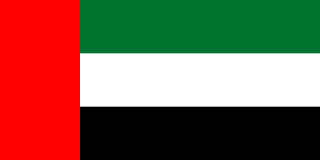
The United Arab Emirates (UAE), or simply the Emirates, is a country in West Asia, in the Middle East, at the eastern end of the Arabian Peninsula. It is a federal, elective monarchy composed of seven emirates, with Abu Dhabi as its capital. It shares land borders with Oman to the east and northwest, and with Saudi Arabia to the southwest; as well as maritime borders in the Persian Gulf with Qatar and Iran, and with Oman in the Gulf of Oman. As of 2024, the UAE has an estimated population of over 10 million, of which 11% are Emiratis; Dubai, is the most populous city, and is an international hub. Islam is the official religion and Arabic is the official language, while English is the most spoken language and the language of business.

The Emirate of Sharjah is one of the emirates of the United Arab Emirates, which covers 2,590 square kilometres (1,000 sq mi) and has a population of over 1,400,000 (2015). It comprises the capital city of Sharjah, after which it is named, and other minor towns and exclaves such as Kalba', Al Dhaid, Dibba Al-Hisn and Khor Fakkan.

Dubai is the most populous city in the United Arab Emirates and the capital of the Emirate of Dubai, the most populated of the country's seven emirates. The city has a population of around 3.6 million, more than 90% of which are expatriates.

Ras Al Khaimah is the northernmost of the seven emirates that make up the United Arab Emirates. The city of Ras Al Khaimah, abbreviated to RAK or RAK City, is the capital of the emirate and home to most of the emirate's residents. It is linked to the Islamic trading port of Julfar. Its name in English means "headland of the tent". The emirate borders Oman's exclave of Musandam, and occupies part of the same peninsula. It covers an area of 2,486 km2 (960 sq mi) and has 64 km (40 mi) of beach coastline. As of 2023, the emirate had a population of about 400,000.

The Emirate of Umm Al Quwain is one of the seven constituent emirates of the United Arab Emirates, located in the north of the country. It is the second smallest and least populous emirate in the UAE and borders the Persian Gulf. Umm Al Quwain lies between Ras Al Khaimah and Sharjah/Ajman on the west coast. It has a coastline stretching to 24 km. It had 72,000 inhabitants in 2007 and has an area of 770 km2 (300 sq mi).

Tourism in Dubai is a major part of the economy of Dubai. Dubai was the third most visited city in the world in 2023 with 17 million international visitors according to Euromonitor International. Dubai hosts more than 800 hotels with more than 150,000 rooms.

The Sheikh Zayed Grand Mosque is located in Abu Dhabi, the capital city of the United Arab Emirates. It is the country's largest mosque, and is the key place of worship for daily Islamic prayers. There is a smaller replica of this mosque in Surakarta, a city in Indonesia. The late Sheikh Zayed bin Sultan Al Nahyan built this mosque to convey historic consequence and to embody the Islamic message of peace, tolerance and diversity.

Saudi Arabia is the second biggest tourist destination in the Middle East with over 16 million visiting in 2017. Although most tourism in Saudi Arabia still largely involves religious pilgrimages, there is growth in the leisure tourism sector. As the tourism sector has been largely boosted lately, the sector is expected to a significant industry for Saudi Arabia, reducing its dependence on oil revenues. This is proved as tourism sector is expected to generate $25 billion in 2019. Potential tourist areas include the Hijaz and Sarawat Mountains, Red Sea diving and a number of ancient ruins.

Sharjah is the third-most populous city in the United Arab Emirates, after Dubai and Abu Dhabi. It is the capital of the Emirate of Sharjah and forms part of the Dubai-Sharjah-Ajman metropolitan area.

The Emiratis are the citizen population of the United Arab Emirates. Within the UAE itself, their number is approximately 1.15 million.

The culture of the United Arab Emirates is part of the culture of Eastern Arabia. Its historical population was a small tribal community that changed with the arrival of an influx of foreign nationals in the mid-20th century. Emirati culture is a blend of Arabian, Islamic, and Persian cultures, with influences from the cultures of East Africa and Indian Subcontinent. Islam has had a prominent influence on local architecture, music, attire, cuisine, and lifestyle.
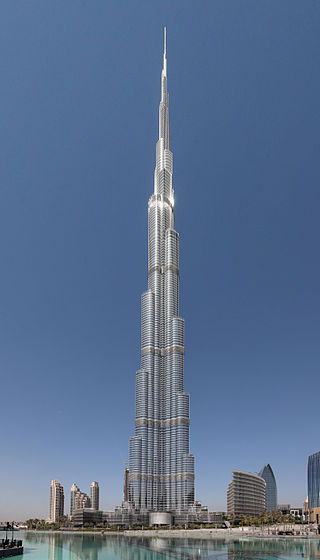
There are many tourist attractions in Dubai, resulting from the large scale construction boom. Dubai received 14 million tourists from all around the world in 2015. Euromonitor ranked the world's 150 most visited cities by international tourists in 2009; Dubai ranked 7th. Dubai welcomed 14.36M visitors in 2022. Dubai's economy relies on many sections of the "state", one of the most important being tourism, in 2014 total 70,475,636 passengers traveled through Dubai Airport.
Cultural policy in Abu Dhabi, a city within the United Arab Emirates, refers to any initiative undertaken by the Emirate government aimed at achieving goals to contribute to or shape culture. Abu Dhabi's government aims to develop a cultural infrastructure that will allow it to establish itself as a reference point for culture on three levels:

Tourism in the Arab World encompasses a wide array of activities and tourist attractions in an area spanning more than 13 million square kilometers. The Arab World mainly consists of the Arabic-speaking countries and populations in North Africa and Western Asia. The standard definition of the Arab world comprises the 22 countries and territories of the Arab League: 10 countries in Africa, and 12 countries in Asia. Geographically, it stretches from the Atlantic Ocean in the west to the Arabian Sea in the east, and from the Mediterranean Sea in the north to the Horn of Africa and the Indian Ocean in the southeast. It has a combined population of around 422 million people.

The Dubai Textile Souk is a traditional souq (market) of textile products in Dubai's historic Bur Dubai neighbourhood, along the Dubai Creek. It is located in the United Arab Emirates. Opposite to the textile souk on the other side of the Dubai Creek lie the Dubai Spice Souk and Dubai Gold Souk in Deira, accessible via the creek by special abra boats. It is open 10am to 10 pm Saturday to Thursday with some vendors taking a lunch break from 1-4pm and Friday is 4 pm to 10pm only. The souks of Dubai have a rich history of trade within the Persian Gulf region and have developed over time as Dubai urbanised rapidly.

The following outline is provided as an overview of and topical guide to Dubai.
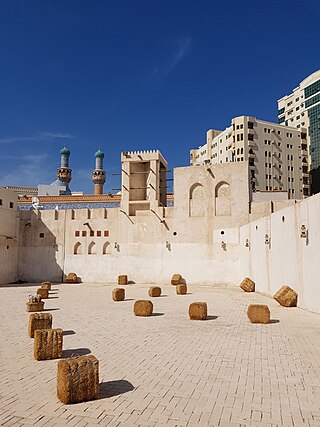
The Heart of Sharjah is a cultural heritage project that aims to preserve and restore the old town of Sharjah in the United Arab Emirates (UAE) and return it to its 1950s state.
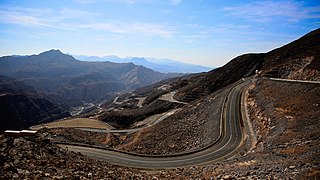
Tourism in the United Arab Emirates is an important part of the Emirati economy. In 2023, the tourism sector employed 809,300 people and contributed 220 billion dirham to the national gross domestic product (GDP), accounting for 12% of it. In 2024, the UAE was the 6th destination globally by international tourism receipts according to the World Tourism rankings, and it ranked 18th globally in the Travel and Tourism Development Index.
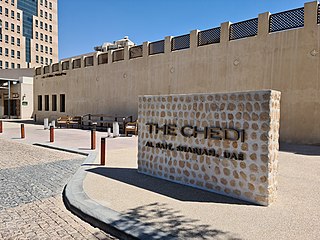
The Chedi Al Bait Hotel is a 53-room five star heritage hotel situated in the Heart of Sharjah cultural heritage area in Sharjah, United Arab Emirates – a restoration of the traditional trading and residential district of Sharjah town.
References
- ↑ "Sharjah — Cultural Capital of the Arab Region in 1998". UNESCO.
- ↑ Kay, Shirley (1992). Sharjah: Heritage and Progress. Motivate Publishing.
- 1 2 Ilyer, Ashok Ganapathy; Deboo, Kairmein; Gandhi, Shweta; Parekh, Dhruv (2019). Architectural & Urban Development of Sharjah: Spatial Analysis of Museums Typology. Sharjah Museums Authority.
- ↑ Hobbs, Joseph John (2017-07-18). "HERITAGE IN THE LIVED ENVIRONMENT OF THE UNITED ARAB EMIRATES AND THE GULF REGION". International Journal of Architectural Research: ArchNet-IJAR. 11 (2): 55. doi: 10.26687/archnet-ijar.v11i2.1240 .
- ↑ Awad, Jihad; Arar, Mohammad; Jung, Chuloh; Boudiaf, Bouzid (2022). "The Comparative Analysis for the New Approach to Three Tourism-Oriented Heritage Districts in the United Arab Emirates". Heritage. 5 (3): 2464–2487. doi: 10.3390/heritage5030128 .
- ↑ UNESCO (2019). "Sharjah. World Book Capital" (PDF). UNESCO Final Report.
- ↑ United Arab Emirates Tours
- ↑ https://www.khaleejtimes.com/uae/from-russia-to-japan-to-uae-an-honour-to-participate-at-sharjah-light-festival-artists-say